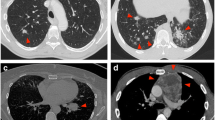Abstract
Purpose
To evaluate four automated devices to achieve transthoracic lung biopsy.
Methods
Transthoracic lung biopsy specimens were obtained randomly from 21 human cadavers with unsuspicious lungs using Biopty (18- and 20-gauge), BIP (18 and 20-gauge), ASAP (18 gauge), and Autovac (18- and 20-gauge) devices. A total of 63 biopsies were carried out with each device and each needle diameter. The same devices and needles were then used randomly for biopsy of peripheral lung metastases. Specimens obtained during both parts of the study were analyzed for the area of tissue on the histologic section, adequacy of tissue for diagnosis, tissue preservation, and crush artifact. The examining pathologist was kept unaware of which procedure was used to obtain the specimens and the cadavers' clinical history.
Results
The Biopty 18-gauge device performed statistically better than any other of the evaluated systems for biopsy of normal lung parenchyma (p < 0.05). For biopsy of lung metastases, the differences between the devices and needle diameters were less, although the Biopty 18-gauge device performed better than the Autovac 18-gauge, BIP 18-gauge, and all 20-gauge devices for the area of tissue on the histologic section (p < 0.05). The results of the full-cut Autovac biopsy system were remarkable because of the large number of biopsies during which no tissue was obtained.
Conclusion
Automated biopsy devices can obtain high quality lung specimens sufficient for definite histopathologic diagnosis. However, additional clinical studies on the use of automated biopsy devices for lung biopsy are mandatory.
Similar content being viewed by others
References
Lindgren PG (1982) Percutaneous needle biopsy: A new technique. Acta Radiol 23:653–656
Parker SH, Hopper KD, Yakes WF, Gibson MD, Ownbey JL, Carter TE (1989) Image-directed percutaneous biopsies with a biopsy gun. Radiology 171:663–669
Poster RB, Jones DB, Spirit BA (1990) Percutaneous pediatric renal biopsy: Use of the biopsy gun. Radiology 176:725–727
Elvin A, Andersson T, Scheibenplug L, Lindgren PG (1990) Biopsy of the pancreas with a biopsy gun. Radiology 176:677–679
Bernardino ME (1990) Automatic biopsy devices: Significance and safety. Radiology 176:615–616
Hopper KD, Baird DE, Reddy VV, Landis JR, Parker SH, Tyler HN Jr, Ownbey JL, McCauslin MA, Yakes WF, Sabatelli FW (1990) Efficacy of automated biopsy guns versus conventional biopsy needles in the pygmy pig. Radiology 176:671–676
Mladinich CRJ, Ackerman N, Berry CR, Buergelt CD, Longmate J (1992) Evaluation and comparison of automated biopsy devices. Radiology 184:845–847
Hopper KD, Abendroth CS, Sturtz KW, Matthews YL, Stevens LA, Shirk SJ (1993) Automated biopsy devices: A blinded evaluation. Radiology 187:653–660
Perlmutt LM, Johnston WW, Dunnick NR (1989) Percutaneous needle aspiration: A review. AJR 152:451–455
Westcott JL (1988) Percutaneous transthoracic needle biopsy. Radiology 169:593–601
Goralnik CH, O'Connell DM, El Yousef SJ, Haaga JR (1988) CT-guided cutting-needle biopsies of selected chest lesions. AJR 151:903–907
Moulton JS, Moore PT (1993) Coaxial percutaneous biopsy technique with automated biopsy devices: Value in improving accuracy and negative predictive value. Radiology 186:515–522
Scheffé H (1953) A method for judging all contrasts in the analysis of variance. Biometrika 40:87–104
Mladinich CRJ, Buergelt CD, Conlon M, Robinson SR (1991) Evaluation and comparison of automated and manual biopsy devices. AALAS Bull 30:9–11
Pokieser P, Kain R, Helbich T, Mallek R, Walter RM, Tscholakoff D, Mostbeck GH (1993) Renal biopsy: In vitro and in vivo comparison of a new automatic biopsy device and conventional biopsy systems. Radiology 186:573–576
Andriole JG, Haaga JR, Adams RB, Nunez C (1983) Biopsy needle characteristics assessed in the laboratory. Radiology 148:659–662
Sokolowski JW, Burgher LW, Jones FL, Patterson JR, Selecky PA (1989) American Thoracic Society: Guidelines for percutaneous transthoracic needle biopsy. Am Rev Respir Dis 140:255–256
Austin JH, Cohen MB (1993) Value of having a cytopathologist present during percutaneous fine-needle aspiration biopsy of lung: Report of 55 cancer patients and metaanalysis of the literature. AJR 160:175–177
Author information
Authors and Affiliations
Rights and permissions
About this article
Cite this article
Wagner, HJ., Barth, P., Schade-Brittinger, C. et al. Postmortem evaluation of four randomly selected automated biopsy devices for transthoracic lung biopsy. Cardiovasc Intervent Radiol 18, 300–306 (1995). https://doi.org/10.1007/BF00203680
Issue Date:
DOI: https://doi.org/10.1007/BF00203680




